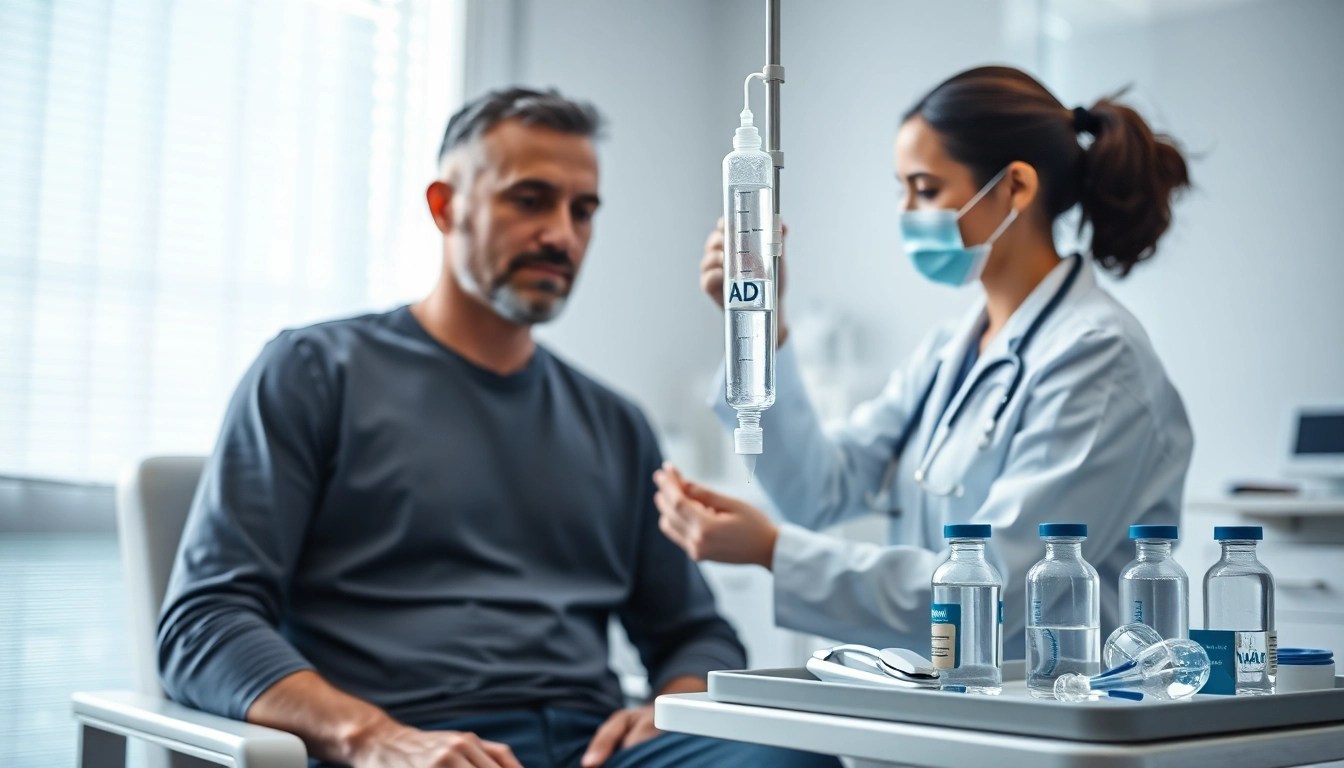What is NAD IV Therapy?
NAD IV therapy, short for nicotinamide adenine dinucleotide intravenous therapy, is a medical treatment that involves the infusion of NAD+, a coenzyme essential for fundamental biochemical processes in the body. This therapy is designed to boost the levels of NAD+, which naturally diminishes with age or due to various health conditions. For a comprehensive explanation on this emerging treatment, check out what is nad iv therapy.
Definition and Overview of NAD
NAD+ is a crucial molecule found in every cell in the human body. It plays a key role in energy metabolism, cellular repair, and maintaining cellular integrity. Furthermore, NAD+ is involved in numerous biochemical reactions that facilitate the conversion of food into energy, DNA repair processes, and regulation of the circadian rhythm. Its fundamental role in energy production makes understanding and replenishing NAD+ levels increasingly significant as we grow older or face health challenges.
Mechanism of Action in the Body
The mechanism by which NAD+ functions can be quite complicated. Primarily, it serves as a coenzyme that assists enzymes in facilitating metabolic reactions and managing the energy metabolism process in the form of adenosine triphosphate (ATP). By sending electrons through the electron transport chain, NAD+ plays a pivotal role in energy production. Additionally, NAD+ can exist in two forms: the oxidized form (NAD+) and the reduced form (NADH), which have distinct roles in metabolism and biochemical pathways.
Components of NAD IV Therapy
NAD IV therapy typically involves a combination of several components:
- NAD+ Infusion: The central element that acts to replace the body’s diminished NAD+ levels.
- Vitamins and Minerals: Additional nutrients may be included to enhance the effectiveness of the therapy, such as B vitamins, which support metabolic processes.
- Hydration: The intravenous route ensures rapid absorption, delivering hydration along with the nutrients directly into the bloodstream, providing immediate access to cellular structures.
Potential Benefits of NAD IV Therapy
Boosting Energy Levels
One of the most touted advantages of NAD IV therapy is its ability to enhance energy levels. By increasing the concentration of NAD+ in the body, this therapy can improve ATP production, the energy currency of our cells. Many patients report feeling an immediate boost in energy and vitality, allowing them to engage more fully in their daily activities.
Enhancing Cognitive Function
NAD+ is not only essential for physical energy but also for cognitive function. Several studies have indicated that increasing NAD+ levels can enhance mental clarity, focus, and cognitive performance. Since NAD+ plays a role in the repair of DNA and the mitigation of oxidative stress, NAD IV therapy may prove beneficial for individuals experiencing cognitive decline or those looking to optimize their brain function.
Supporting Cellular Health
Cellular health is critical for overall well-being. NAD+ is instrumental in promoting healthy cellular processes, including DNA repair and cellular regeneration. By increasing NAD+ levels through IV therapy, individuals may experience a slowdown in age-related cellular degradation and increased resistance to genetic damage, leading to healthier cellular function and longevity.
Who Can Benefit from NAD IV Therapy?
Common Indications for Treatment
NAD IV therapy can be suitable for a wide range of individuals, including:
- Those experiencing chronic fatigue or low energy levels.
- Individuals recovering from addiction, as NAD+ can aid in restoring neurochemical balance.
- Patients seeking improved athletic performance or faster recovery from exercise.
- Individuals with neurodegenerative disorders who wish to enhance brain health.
Age-Related Health Considerations
As we age, our NAD+ levels naturally decline, leading to a variety of health issues such as diminished energy, increased fatigue, and cognitive impairment. NAD IV therapy may provide a feasible solution to mitigate these age-related concerns by replenishing NAD+ levels and supporting overall health.
Conditions Addressed by NAD Therapy
NAD IV therapy is being explored for various medical conditions, including:
- Addiction recovery: Helps reduce withdrawal symptoms and cravings.
- Chronic fatigue syndrome: Boosts energy levels and reduces fatigue feelings.
- Neurodegenerative disorders: Potentially helps in the management of conditions like Alzheimer’s and Parkinson’s.
- Metabolic certain disorders: Assists in regulating metabolic functions and promoting weight management.
What to Expect During a NAD IV Therapy Session
Preparation and Consultation Process
Before undergoing NAD IV therapy, patients should have a detailed consultation with their healthcare provider to assess their needs and potential contraindications. Preparations may include avoiding certain medications or supplements for a short time before treatment.
Procedure Overview and Duration
The procedure for NAD IV therapy generally involves the following steps:
- A healthcare professional will insert an IV catheter into the patient’s vein.
- The NAD+ solution will be slowly infused over a specified duration, typically ranging from 1 to 4 hours, depending on the prescribed protocol.
- Patients are monitored throughout the session to ensure comfort and safety.
Post-Treatment Care and Recovery
Following the session, patients may be advised to drink plenty of water and rest to maximize the therapy’s benefits. Many individuals report feeling refreshed and energized after the session, while some may experience mild side effects, which can be discussed with their healthcare provider.
Safety and Considerations Related to NAD IV Therapy
Potential Side Effects and Risks
Generally considered safe, NAD IV therapy may still have some risks. Common side effects can include:
- Headaches
- Nausea
- Fatigue
- Injection site reactions
Patients should communicate any adverse effects they experience with their healthcare provider.
Who Should Avoid NAD IV Therapy?
NAD IV therapy may not be suitable for everyone. Potential contraindications include individuals with:
- Allergic reactions to NAD+ or IV components
- Severe heart or renal disease
- Pregnancy or breastfeeding
A thorough medical history review during the consultation will help identify suitable candidates for this therapy.
Consulting with Healthcare Providers
It is crucial for individuals considering NAD IV therapy to consult with qualified healthcare providers who understand the therapy’s implications and can provide the necessary guidance and monitoring throughout the process. They can help personalize the treatment based on an individual’s health history and goals.



